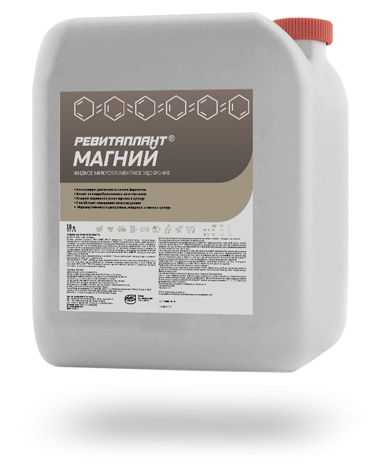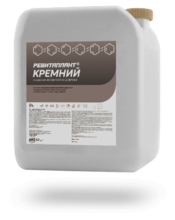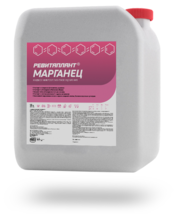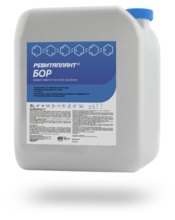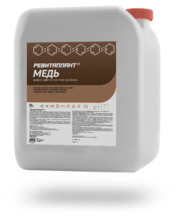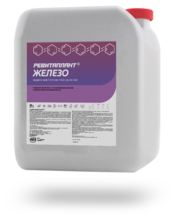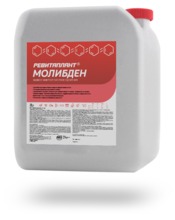Ingredients
Active ingredient content by molecular weight, g/l
Goals / Purpose
| Crop | Input rate | Input stage | Remarks | |
|---|---|---|---|---|
| Crop: | Input rate: 0,5–1 l/ha | Input stage: Booting | Remarks: Remedy of nutrient deficiency, boosting enzymatic processes, enhancing photosynthesis and sugar generation, speeding-up the formation of fats, oils and increasing starch accumulation | Details |
| Crop: | Input rate: 0,5–1 l/ha | Input stage: Earing | Remarks: Remedy of nutrient deficiency, boosting enzymatic processes, enhancing photosynthesis and sugar generation, speeding-up the formation of fats, oils and increasing starch accumulation | Details |
| Crop: | Input rate: 0,5–1 l/ha | Input stage: 1st tier leaves | Remarks: Remedy of nutrient deficiency, boosting enzymatic processes, enhancing photosynthesis and sugar generation, speeding-up the formation of fats, oils and increasing starch accumulation | Details |
| Crop: | Input rate: 0,5–1 l/ha | Input stage: Budding | Remarks: Remedy of nutrient deficiency, boosting enzymatic processes, enhancing photosynthesis and sugar generation, speeding-up the formation of fats, oils and increasing starch accumulation | Details |
| Crop: | Input rate: 0,5–1 l/ha | Input stage: 2-4 leaf pairs | Remarks: Remedy of nutrient deficiency, boosting enzymatic processes, enhancing photosynthesis and sugar generation, speeding-up the formation of fats, oils and increasing starch accumulation | Details |
| Crop: | Input rate: 0,5–1 l/ha | Input stage: 6-8 leaf pairs | Remarks: Remedy of nutrient deficiency, boosting enzymatic processes, enhancing photosynthesis and sugar generation, speeding-up the formation of fats, oils and increasing starch accumulation | Details |
| Crop: | Input rate: 0,5–1 l/ha | Input stage: Ramification | Remarks: Remedy of nutrient deficiency, boosting enzymatic processes, enhancing photosynthesis and sugar generation, speeding-up the formation of fats, oils and increasing starch accumulation | Details |
| Crop: | Input rate: 0,5–1 l/ha | Input stage: 6-7 leaves | Remarks: Remedy of nutrient deficiency, boosting enzymatic processes, enhancing photosynthesis and sugar generation, speeding-up the formation of fats, oils and increasing starch accumulation | Details |
| Crop: | Input rate: 0,5–1 l/ha | Input stage: Tasseling | Remarks: Remedy of nutrient deficiency, boosting enzymatic processes, enhancing photosynthesis and sugar generation, speeding-up the formation of fats, oils and increasing starch accumulation | Details |
| Crop: | Input rate: 0,5–1 l/ha | Input stage: In autumn, for winter rapeseed at 5-6 leaves’ stage | Remarks: Remedy of nutrient deficiency, boosting enzymatic processes, enhancing photosynthesis and sugar generation, speeding-up the formation of fats, oils and increasing starch accumulation | Details |
| Crop: | Input rate: 0,5–1 l/ha | Input stage: Budding | Remarks: Remedy of nutrient deficiency, boosting enzymatic processes, enhancing photosynthesis and sugar generation, speeding-up the formation of fats, oils and increasing starch accumulation | Details |
| Crop: | Input rate: 0,5–1 l/ha | Input stage: Budding | Remarks: Remedy of nutrient deficiency, boosting enzymatic processes, enhancing photosynthesis and sugar generation, speeding-up the formation of fats, oils and increasing starch accumulation | Details |
| Crop: | Input rate: 0,5–1 l/ha | Input stage: Two weeks after the first application | Remarks: Remedy of nutrient deficiency, boosting enzymatic processes, enhancing photosynthesis and sugar generation, speeding-up the formation of fats, oils and increasing starch accumulation | Details |
| Crop: | Input rate: 0,5–1 l/ha | Input stage: Before flowering | Remarks: Remedy of nutrient deficiency, boosting enzymatic processes, enhancing photosynthesis and sugar generation, speeding-up the formation of fats, oils and increasing starch accumulation | Details |
| Crop: | Input rate: 0,5–1 l/ha | Input stage: After flowering | Remarks: Remedy of nutrient deficiency, boosting enzymatic processes, enhancing photosynthesis and sugar generation, speeding-up the formation of fats, oils and increasing starch accumulation | Details |
| Crop: | Input rate: 0,5–1 l/ha | Input stage: Fruit setting | Remarks: Remedy of nutrient deficiency, boosting enzymatic processes, enhancing photosynthesis and sugar generation, speeding-up the formation of fats, oils and increasing starch accumulation | Details |
| Crop: | Input rate: 0,5–1 l/ha | Input stage: Budding | Remarks: Remedy of nutrient deficiency, boosting enzymatic processes, enhancing photosynthesis and sugar generation, speeding-up the formation of fats, oils and increasing starch accumulation | Details |
| Crop: | Input rate: 0,5–1 l/ha | Input stage: Two weeks after the first application | Remarks: Remedy of nutrient deficiency, boosting enzymatic processes, enhancing photosynthesis and sugar generation, speeding-up the formation of fats, oils and increasing starch accumulation | Details |
| Crop: | Input rate: 0,5–1 l/ha | Input stage: 4-6 pairs of real leaves | Remarks: Remedy of nutrient deficiency, boosting enzymatic processes, enhancing photosynthesis and sugar generation, speeding-up the formation of fats, oils and increasing starch accumulation | Details |
| Crop: | Input rate: 0,5–1 l/ha | Input stage: 8-10 pairs of real leaves | Remarks: Remedy of nutrient deficiency, boosting enzymatic processes, enhancing photosynthesis and sugar generation, speeding-up the formation of fats, oils and increasing starch accumulation | Details |
| Crop: | Input rate: 0,5–1 l/ha | Input stage: 50% closing of crop | Remarks: Remedy of nutrient deficiency, boosting enzymatic processes, enhancing photosynthesis and sugar generation, speeding-up the formation of fats, oils and increasing starch accumulation | Details |
Description
Magnesium is a part of chlorophyll and is directly involved in photosynthesis. Chlorophyll contains about 10% of its total magnesium in the green parts of plants. The formation of such pigments as xanthophyll and carotene in leaves pertains also to magnesium. Magnesium is also part of the phytin, the reserve substance found in the seeds of plants, and pectins. Around 70–75% of Mg in plants are in mineral form, mostly as ions.
Magnesium enables many enzymes involved in the formation and conversion of carbohydrates, proteins, organic acids, fats; influences the movement and conversion of phosphorus compounds, accelerates the seed ripening of cereals; helps to improve the crop quality, raises the content of fat and carbohydrates in plants, and frost resistance of citrus fruits, orchard crops and winter crops.
The highest magnesium content in the vegetative organs of plants is observed during the flowering period. After flowering the amount of chlorophyll in the plant plummets, and magnesium flows from leaves and stems to seeds, where phytin and magnesium phosphate are formed. Consequently, magnesium, like potassium, can move in a plant from one organ to another.
